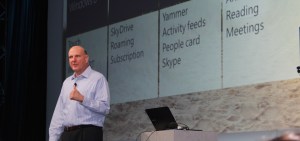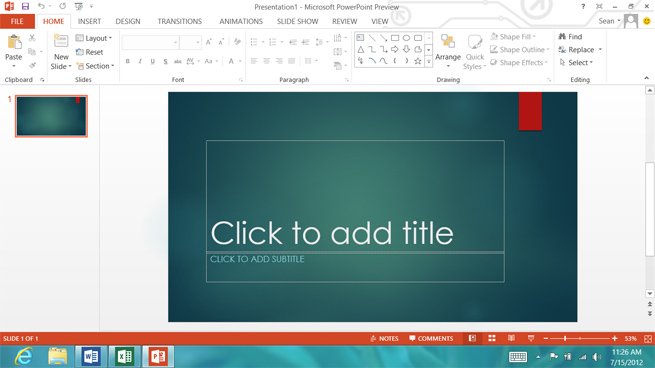
Microsoft has finally announced Office 2013, a modern, touch-friendly, and cloud-connected version of its widely used productivity suite.
The next 12 months will bring major changes for Microsoft, which will release a new version of Office, its Windows 8 operating system, Windows Phone 8 for smartphones, Xbox 360’s ambitious SmartGlass software, an updated Windows Azure with IaaS support that will take on Amazon Web Services, and more. But today is all about Office 2013.
And Office 2013 is all about the cloud. “Your modern office thinks cloud first,” Microsoft CEO Steve Ballmer said at a press conference in San Francisco today. “We use cloud to help you remember what you were doing and where you were.”
“We are transitioning the office business as a cloud business,” added Kirk Koenigsbauer, Microsoft’s corporate vice president, who took the stage shortly after Ballmer.
The modern office also includes increased support for Windows 8 and integration with social enterprise networking systems like Yammer, which Microsoft acquired this June. “Yammer will accelerate our position in the social networking space,” Koenigsbauer said of the $1.2 billion acquisition.
All of the programs you’ve known for years — Word, Excel, PowerPoint, Outlook, and more — have been reimagined by Microsoft in a way to move the software forward without changing it enough to be alienating. It will work across desktops, laptops, tablets, and phones; like Windows 8, it is trying to be more versatile in how it can be used than ever before.
Koenigsbauer announced an update to Microsoft SharePoint to include more social and collaborative features, such as contact information aggregated from your social feeds and recommendations of documents to read and share based on your interests. For the first time, a Skype service will be integrated into Office to start video calls in seconds.
Microsoft claims that the new version of Office was made with Windows 8 in mind, but most of the new apps are disappointingly not built with the company’s full-screen Metro design. Only OneNote and Lync have been built as Metro-style apps, while all of the other apps are meant to be used on the standard Windows desktop. However, all of the apps have been built with touch in mind, so the programs can work well with tablets running Windows 8, such as Microsoft’s Surface.
One of the more notable changes is that many apps, including Word, Excel, and PowerPoint, have a handy start screen that shows popular template options. Another big change is the ability to save documents directly to your SkyDrive folder in the cloud as a default — that way your docs are stored in the cloud and accessible across several devices tied to SkyDrive. It’s also cloud-connected with features from Office 365.
SkyDrive is fundamental to the new release as it’s where Microsoft will be storing all your documents (photos, videos, images and more) in the cloud.
Check out our full hands-on impression of Office 2013 to get a better idea of more software changes.
Microsoft has not revealed when it will be releasing this new version of Office, but we expect it to be ready to go for the release of Windows 8 in late October. Pricing details for Office 2013 were also not disclosed.
Christina Farr contributed additional reporting to this story.
Take a look at the slides below for more looks at Office 2013:
[vb_gallery id=491454]


